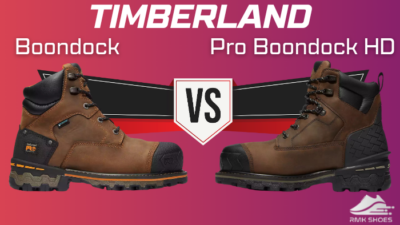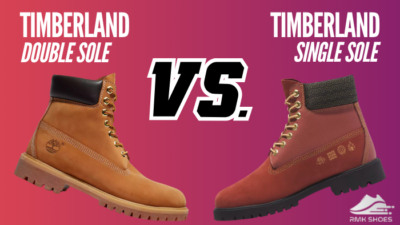If you’re at all familiar with the athletic or sports footwear industry, I’m sure you’ve heard of APL and Hoka.
These two shoes are able to beat each other with a combination of various beneficial features. So naturally, it becomes difficult for common folks to decide between these two shoes.
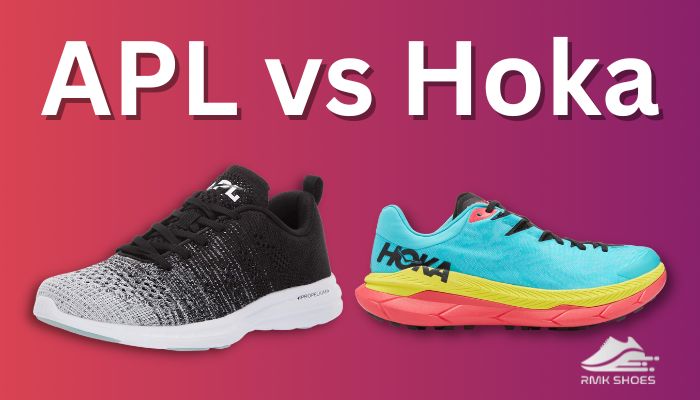
Hence, I thought comparing their features side by side would make it easier for my readers to pick one.
Without further delay, go through the detailed discussion of Hoka & APL!
A Brief Overview of APL and Hoka
APL started its journey from Los Angles in March 2009. The elaboration of APL is Athletic Propulsion Labs, which simply represents Men’s and Women’s activewear, including shoes and other apparel.
The company is eager to innovate and upgrade its technology. It always tries to create performance-oriented footwear with a lavish vibe.
APL states that its Concept 1 Basketball Shoe featured groundbreaking Load N’ Launch®, which increases vertical leap instantly. So, the NBA banned the footwear, saying it provides an undue competitive advantage to the player.
APL’s products became coveted soon after its debut for their worth-mentioning facilities, such as the intersection of luxury and performance, groundbreaking technology, unique design, etc.
The bestselling items from this brand are TechLoom Zipline, TechLoom Bliss, TechLoom Breeze, TechLoom Defender, and Tracer.
Hoka is well-known enough; you must’ve heard about its name & fame. At first, it was focused on making shoes for mountaineers. Then it turns toward pro runners, ultra-marathoners, and athletes.
The designers implement three core technologies in each and every Hoka shoe. Those are Meta-Rocker tech for propulsion, cushioned midsole for support, and Active Foot Frame for stability.
With top-notch features and a catchphrase that – Innovation is the Heart of Hoka, the brand has acquired a huge portion of worldwide consumers.
What’s the Difference Between Hoka & APL?
Core materials, inserted technology, outlook, cushioning, and price point are the most important factors that differ between Hoka and APL. Though they are similar in functionalities i.e., both are eligible for training, running, and other physical workouts.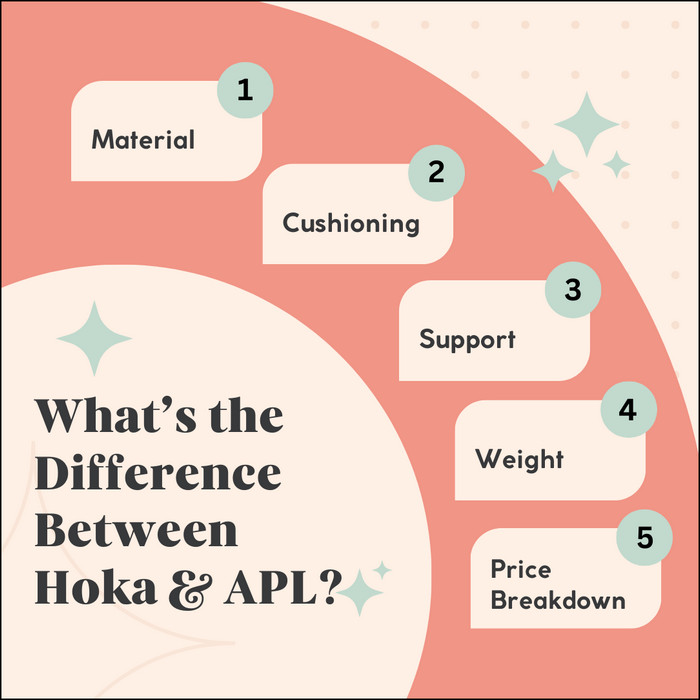
Now, let’s compare Hoka and APL based on their signature characteristics:
1. Material
The upper of Hoka is built with an engineered knit upper. It is breathable and lightweight. The outsole and midsole are based on Durabrasion rubber and EVA foam, respectively.
Besides other portions, such as lace, the toe area is made with recycled polyester and mesh. These sustainable materials take Hokas” durability and comfort to the peak level.
APL has its own knitted material, known as TechLoom. It’s a non-stretchy and breathable fabric to keep feet away from sweat. The contoured Lycra collar and tongue add extra coziness to the wearers.
APL’s Propelium™ midsole is superior to Hoka due to maintaining long structural integrity over conventional EVA. However, there is no difference in the sole exterior material of the two as both are made of long-lasting rubber.
2. Cushioning
Depending on the thickness, Hokas cushioning can be divided into three parts: Plush, Balanced, and Responsive.
The Plush has a thicker bed of soft cushion, which is relatively more comfortable. And the balanced one is stable, as the name implies. Responsive cushion keeps feet close to the surface and assists to push-off instantly.
On the other hand, APL’s cushion is totally sourced from its lightweight Propelium™ and sock liner.
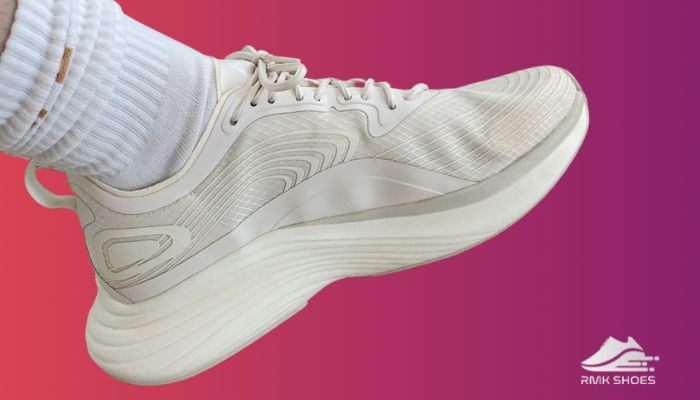
Actually, cushioning is a matter of feeling. When you wear the shoes, you will get to realize it better. It is not possible to give a real idea about cushions or padding by describing the material.
Thus, I tested Hoka Clifton 9 and APL’s TechLoom Tracer in the morning jog. Clifton’s cushion is balanced; it has provided a pleasant interior and made me agree that Hoka is good for walking.
Contrarily, TechLoom Tracer seemed to be more cozy and cushiony from all sides.
Even some of my team members found APL more comfortable after wearing other pairs of Hoka and APL, which means APL deserves the winning trophy in this phase.
3. Support
For both brands, support changes depending on the model. While moderate support is delivered by Clifton 9, Hoka Arahi 6 gives the utmost support with additional J-Frame™ technology. It acts against overpronation and promotes smooth stride.
As a result, if you compare APL and Hoka Arahi 6’, you will find the latter more supportive. But if the comparison takes place between APL and Hoka Clifton, the former is the clear winner.
However, I think sticking with Hoka is safe for racers who are concerned about speed. Because it simultaneously assures forefoot support and stability with Rocker shoe technology.
The Early Stage Meta-Rocker’s curved structure helps the runner to propel forward instead of landing flat. Whereas Late Stage Meta-Rocker enhances stability and forefoot support.
4. Weight
Just making a glimpse at Hoka and APL, can you guess which one is heavier?
Well, most Hoka shoes are weighty than APL due to their higher sole height. APL weighs only 7.9 oz per shoe. But Hoka’s weight varies according to the style. For instance, Bondi 8 is 8.90 oz, and Speedgoat 5 GTX Spike is 12.30 oz.
But don’t be surprised if you see Hoka shoes in the market that are lighter than APL. There are some such designs, one of which is the women’s Arahi 6 weighs only 7.60 oz.
5. Price Breakdown
Hokas are available for $80 to $275. It’s best-performing training, running, and hiking shoe retail for $140 to $250.
APL also demands a fair price for its powerful shoes; however, the range is expensive compared to Hoka. Their prices start from 90 US dollars and reach a maximum of 345 dollars.
If you prefer somewhat more advantages from APL, you will have to invest more. Because I have checked its TechLoom Zipline’s ($320) functionalities. It is just a masterpiece for advanced runners, which features a super comfy FutureFoam midsole, lateral and longitudinal support with a slanted shank, and sleek texture.
Pros & Cons of APL and Hoka
APL
- »Lightweight & breathable.
- »Durable fabric.
- »Stylish design.
- »Enriched with a bunch of modern techs.
- »Good for heavy activities like sports, races & training.
- »Unisex shoe.
- »Produces half-sizes shoes.
- »Fashionable colors
- »Expensive.
- »The fit varies as per the model.
Hoka
- »Supportive & stable.
- »Durable & Adequately cushioned.
- »Inspire to run faster, so good for running.
- »Wide range of varieties and color options.
- »Serves regular and wide feet.
- »Slip & water-resistant.
- »Waterproof GTX sets are also available.
- »Chunky sole.
- »Heavy and costly.
Which One is Better?
It’s time to summarize Hoka and APL so that you can instantly make up a decision. You should choose between these shoes based on your top priority.
If your primary concern is to get top-notch support from a lightweight shoe, then nothing can be better than Hoka in a medium price range.
Its eye-catching colors, bold appearance, maximum comfort & well ventilation will definitely assure you a great experience on your sports field, running surface, or gym.
Otherwise, opt for APL if you don’t mind spending a little more money on an all-in-one shoe. Because this footwear is a blessing that packs the entire benefits. You can use it as a regular shoe for everyday life and also for heavy exercises.
Conclusion
Now you know enough about APL and Hoka. Although their price is a bit high, considering their features, they are worth the price.
After reading this article, which one are you leaning towards between these brands?
Let me know in the comment section. Feel free to ask for more information regarding any footwear.
See you at the next one!

